Hawthorn (Crataegus) include MANY edible varieties
The Hawthorn genus (Crataegus) includes nearly 200 named species, and some are sold heavily as a health remedy. Many varieties of Hawthorn bear fruit, and are native around the world. They are mainly trees and some are shrubs. Common Hawthorn traits are: showy flowers; beautiful dark green lobed leaves; bear fruit that resembles a small red apple; grows in any soil; takes semi-shade or full sun; needs average soil moisture; and not a fussy tree (“forgiving”, low maintenance).
HEPPY™ selected to grow the Crataegus with the longest history of providing great health, the Chinese Hawthorn, Shān zhā (Crataegus pinnatifida). This page provides details about the C. pinnatifida after highlighting the many varieties of Crataegus that also provide edible berries.
the Chinese Hawthorn (Crataegus pinnatifida) is highly versatile. it’s berries are used in virtually every food-making process, the tree itself is attractive and tolerates many conditions (wet/dry, diverse soils, etc), and we mentioned its very long history in China of providing health benefits. it’s a HEPPY tree for sure. we grow the ‘Red Sun Chinese Haw’ cultivar at HEPPY.
I count eight (8) Hawthorn trees with edible berries ranked “5 out of 5;” and the USDA lists over 175 named Hawthorns! as of today, additional Hawthorns on our “wish list” — to research, buy, and plant — are the Gold Azarole Hawthorn (Crataegus azarolus), the Mayhaw (Crataegus aestivalis), Oneseed Hawthorn (Crataegus monogyna), and Midland Hawthorn (Crataegus laevigata).
HEPPY will explore the value that Hawthorn trees provide — volunteer or donate to move this project forward.
________________________________________
see our list of 400 edible plants
YouTube channel (please subscribe)
Chinese Hawthorn in garden design, permaculture, and organic gardening
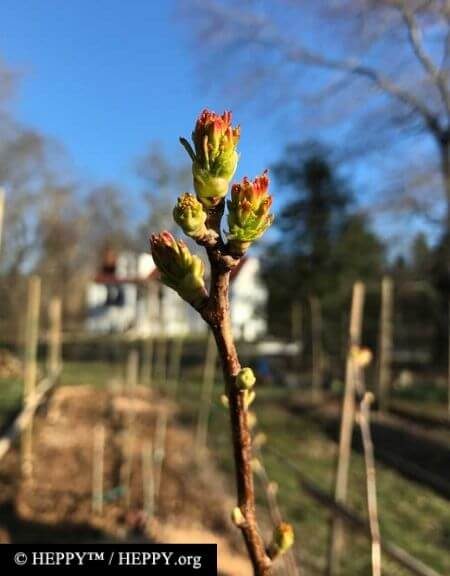
‘Red Sun Chinese Haw’ Hawthorn, Crataegus pinnatifida
common names: Shān zhā, Chinese Hawthorn, Chinese Haw, Red Sun Chinese Hawthorn.
Plant Fact Sheet
Zone: 5 to 9
Height: 20 – 25 feet
Native: China, Korea and East Asia
Bloom Time: April – May
Bloom Color: white (clusters of small white flowers)
Fruit Maturity: Sept – Oct
Self-fertile: yes
Sun: full (will tolerate all types of shade but produces less fruit)
Water: medium (will tolerate drought & occasional wet soil)
Soil: forgiving (wide range but prefers loamy soil)
Maintenance: low (a forgiving tree)
Growth Rate: fast
Deciduous or evergreen: deciduous
Edible¹: fruit (more information is below)
Medicinal²: yes (discussed below)
Commercial viability: strong (discussed below)
Family / Genus: Rosaceae / Crataegus
Remarks: an attractive tree; pest resistant; very versatile and adaptive; long history in China for its medicinal qualities; very versatile fruit; self-fertile
*** NOTE that I’ve heard that the Chinese Hawthorn has thorns but I’ve not seen any here at HEPPY. below, we’ll tell you how she’s doing!
Variety of Hawthorn trees (Crataegus) that produce hawthorn berries
Gold Azarole Hawthorn (Crataegus azarolus)
USDA hardiness zones 5-9, the fruit is eaten fresh in warmer temperatures where the fruit develops more fruit sugars, and has a fragrant sugary pulp with a slightly acid flavor. the tree grows up to 20 feet tall.
also known as the Mediterranean Medlar, it’s native to the Mediterranean Basin and is a common plant there. In the Arab countries it is the commonest of the hawthorn species. the Gold Azarole is heat tolerant and withstands dryer soils once established.
Nurseries such as One Green World and Rolling River have them in-stock occasionally; seeds are on Amazon (buying any seeds from Amazon can be sketchy — read reviews).
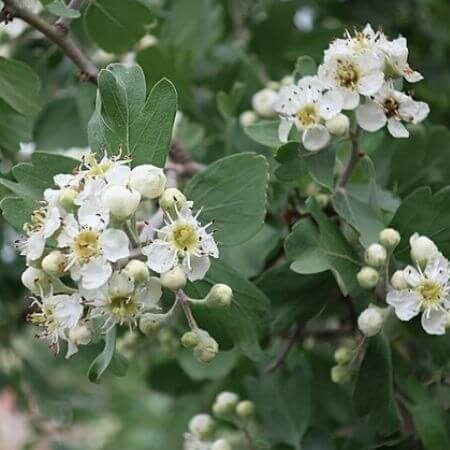
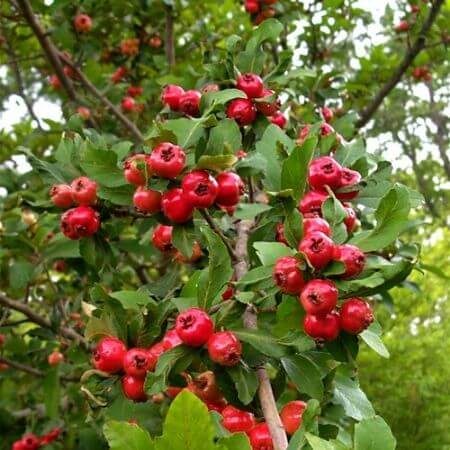
Mayhaw (Crataegus aestivalis & Crataegus opaca)
“Mayhaw” is the most commonly known Hawthorn in North America. but it’s not that easy for the tree with SO many varieties. the Louisiana Mayhaw Association describes the Mayhaw as, Crataegus opaca — the Western Mayhaw. The Eastern Mayhaw is the Crataegus aestivalis. this distinction matters if you’d like a variety in-line with what the commercial industry is doing for this unusual fruit.
USDA hardiness zones 6-11, the fruit is frequently used for preserves and jellies and can also be dried for later use. Crataegus aestivalis provides erosion control (stream-bank stabilization). the tree benefits wildlife by providing nesting sites and cover for small birds. Birds and small mammals eat the fruit. Buying Mayhaw is tricky — there’s so many varieties with the name, Mayhaw. Willis Orchard Company lists 4 varieties and the tree can be purchased on Amazon.com.
this website produced an excellent comprehensive webpage about the Mayhaw.
Oneseed Hawthorn (Crataegus monogyna)
also known as the Common or Single-seeded Hawthorn, her range is from Southern California to Alaska. that’s amazingly adaptable. Oneseed are self-pollinating, and can be pruned as a hedge or allowed to grow into a tree.
this species is native to Europe, Northwest Africa and West Asia. according to USDA PLANTS, the State of California placed Oneseed in its Invasive Species Inventory. California is sub-tropical and likely supports self-seeding.
it’s blooms are reddish and white. so it’s clusters of flowers look like large red/white carnations.
Oneseed is difficult to find in nurseries. keep Googling and you’ll may find plants available for sale. Crataegus monogyna seeds are on Amazon (buying any seeds from Amazon can be sketchy — read reviews).
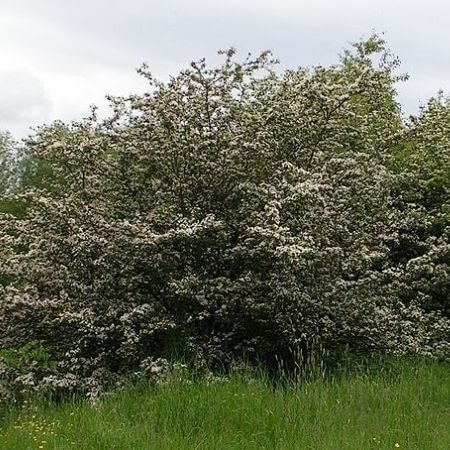
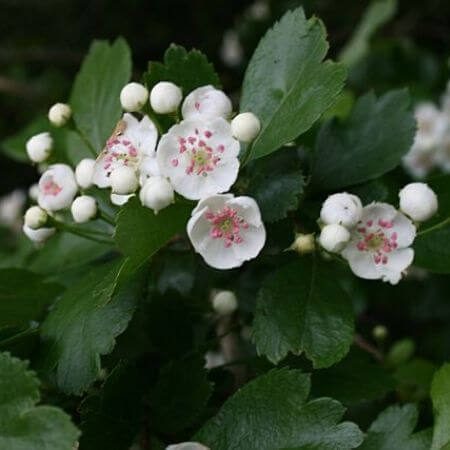
English Hawthorn (Crataegus laevigata)
also known as the Midland, Whitethorn or Woodland Hawthorn, her range is across the United States. Midland are self-pollinating. but this variety is better known in Europe.
this species’ range from England and Sweden, to Spain, and eastward to Poland. it produces spectacular blooms, and fruit that are edible and have medicinal qualities.
the leaves and flowers as well as the fruits of Crataegus monogyna and Crataegus laevigata are used in European herbal traditions. both of these species occur throughout Europe.
Nurseries such as Rolling River have them in-stock occasionally; seeds are on Amazon (buying any seeds from Amazon can be sketchy — read reviews).
EIGHT varieties of Hawthorn (Crataegus) ranked HIGHEST for edible fruits
Plants For A Future as one online source we trust. they cite their work, which provides a basis for their content (and I read many cited works to learn more!).
they rank Crataegus by edibility and list EIGHT ranked at “5” — the highest rank for edibility. this opened-up a few more Crataegus that we — all of us — should get to know. these “Tasty 8” grow in plant zones 3-9 (all grow in zones 6 & 7), and have all the similar Hawthorns traits (showy flowers; and grows in any soil, semi-shade or full sun, and needs average soil moisture).
1. Arnold Hawthorn (Crataegus arnoldiana). Native to North America; cooler climates appears to be its habitat.
2. [little is known] (Crataegus festiva). Recognized in England; a rare find in the States.
3. [little is known] (Crataegus missouriensis). Recognized in England; a rare find in the States.
4. Scarlet Hawthorn (Crataegus pedicellata). Native to North America; broad habitat.
5. Pennsylvania Hawthorn (Crataegus pennsylvanica). Native to North America.
6. Blue Hawthorn (Crataegus schraderana). Recognized in England; would be rare to find in the States.
7. Tansy-Leaved Thorn (Crataegus tanacetifolia). Native in Turkey.
8. Haw x Mountain Ash (x Sorbocrataegus hybrid).
At LEAST another 175 varieties of Hawthorn (Crataegus)
USDA PLANTS Database as a premier online source. they are the source to cite. they list 179 named Hawthorn plants, each has a unique spices name (eg, Crataegus pinnatifida).
Add the word “Hawthorn” to each plant below:
Adorned; Aiken; Alabama; Albany; Albertville; Arnold; Azarole; Barberry; Batesburg; Beadle’s; Beautiful; Bedford Springs; Berks County; Bigfruit; Black; Blanchard’s; Blueberry; Bountiful; Brainerd’s; Brazos; Broadleaf; Buffalo; Canadian; Carolina; Caughuawaga; Celotti’s; Cerro; Chinese; Chinese Haw; Clarkton; Clustered; Cockspur; Cogswell’s; Cole’s; Concord; Confederate; Connecticut; Copenhagen; Dallas; Densewoods; Desert; Distinct; Dixie; Dodge’s; Dotted; Downy; Duke; Dunbar’s; Dwarf; Dyed; Elegant; Engelmann’s; Essex; Eureka Springs; Fanleaf; Fireberry; Fleshy; Florida; Forbes’s; Fort Bend; Fort Sheridan; Fragile; Franklin’s; Fuller’s; Fulton; Gadsden; Gallion; Glossy; Graceful; Grand; Grand Rapids; Great Smoky Mountain; Green; Gregg’s; Grove; Gulf; Harbison’s; Harvey’s; Hoary; Holmes’; Hybrid; Illinois; Jesup’s; Jeweled; Johnny Reb; Kansas; Kellogg’s; Keystone; Kingston’s; Knieskern’s; Lake Ella; Lemington; Littlehip; Lonestar; Mansfield; Manzanita Tejocotera; Margarett’s; Marietta; May; Menand’s; Mink; Minute; Miss Jones’; Miss Vail’s; Mississippi; Montgomery; Nashville; New London; New York; Nixon’s; Northern; Nude; Okanagan Valley; O’kennon’s; Oldmaid; Oneseed; Ontario Ovateleaf; Ozark; Parsley; Pear; Pearson’s; Pearthorn; Pennsylvania; Pensacola; Phipps’; Phoenix City; Pineland; Piper’s; Pittsburgh; Plumleaf; Port Huron; Prairie; Pringle’s; Quebec; Red; Red Haw; Redclay; Reverchon’s; River; River Junction; Rochester; Rockmart; Rome; Rough; Roundleaf; Rusty; Sargent’s; Sawtooth; Scarlet; Schuette’s; Scranton; Shafer’s; Shiningbranch; Slender; Smooth; Southern; Spreading; Stolonbearing; Suksdorf’s; Sutherland; Tallahassee; Texas; Threeflower; Tissueleaf; Tracy’s; Turner’s; Valley Head; Warm Springs; Warner’s; Washington; Waterloving; Waxyfruit; Western Mayhaw; Williams’; Willow; Woolly; Wooton’s; Yellowleaf.
Crataegus encompass a large group of Hawthorns.
Hawthorn in landscaping and garden ideas
‘Red Sun’ Chinese (Crataegus pinnatifida) cultivar is growing at HEPPY™. it’s not native to North America but perfectly adapted and is not invasive. this cultivar IS prone to getting rust (content about Crataegus dieseases is forthcoming).
Landscape Architecture
in landscape architecture, the ‘Red Sun’ Chinese Hawthorn is an excellent single accent tree. it’s a beautifully shaped tree and well mannered. it’s shape is easy to maintain; for example, it does not “bolt” upward as do our pear trees (commercial plums bolt upward too). its lovely white flowers are followed by fruit that are colored red. and in the background are deep green leaves — leaves that are lobed much like some oak trees. its new shoots (new leaf growth) are richly colored, presenting showy shades of lime-green and red. it’s an attractive tree.
Garden Ideas
Crataegus pinnatifida is incredibly versatile. it grows in part shade; however, plant the tree in full sun to assure many showy flowers, fruit and good air circulation. the one risk to the Hawthorn is rust — avoid planting near Juniper or Cedar if possible (a half-mile radius).
Crataegus tolerate virtually all soils and can tolerate drought (once established); Crataegus pinnatifida prefers well-drained soil and moisture. at HEPPY, we planted our Red Sun Chinese Hawthorn in our classic 5’ x 5’ x 3’ highly organic tree plot (Fall 2018) and watched it explode in Spring 2019. the tree grows fast and is non-invasive.
Crataegus pinnatifida is truly self-pollinating. its fruit is a medium-to-dark red color, not shiny, and shaped like a mini apple. it has small seeds that are so tightly packed, it acts as one seed.
Crataegus are highly adaptive; MOST varieties grow between zones 4-9
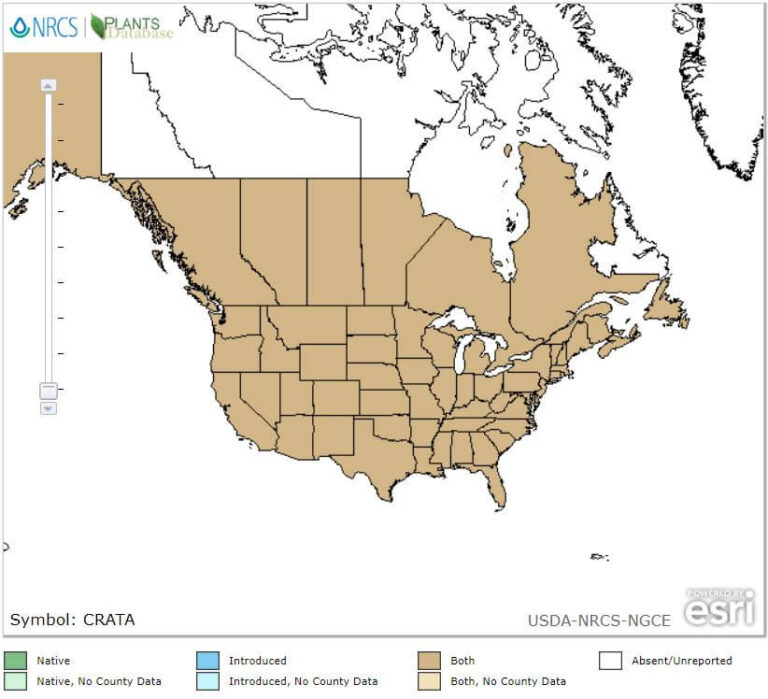
edible Chinese Hawthorn - how ‘Red Sun Chinese Haw’ can be eaten and used medicinally
1, 2 HEPPY cannot take any responsibility for any adverse effects from the use of plants. Always seek advice from a professional before using a plant for food or medicinally. This information is intended for educational purposes only and should not be considered as a recommendation or an endorsement of any particular medical or health treatment.
Edible fruit
Chinese Hawthorn fruit can be eaten many different ways; from using ancient and contemporary Chinese methods, to your own ingenuity and creativity.
the fruit can be eaten fresh. it’s described as a flavorful fruit; I believe the Red Sun Chinese cultivar was grown to produce a better fruit (among other traits). tea, dried (“fruit leather”), stewed, candied, baked into pies and cakes, jellies and preserves, and it’s been added to drinks and as a meat marinade. The Chinese Hawthorn has a long history in China for a reason.
Recipes
Healthy Homemade Hawthorn Jam is offered by this website. very straightforward recipe. Hawthorn Tincture, Vinegar, Cocktail and more is offered by Southeast Wise Women.
Medicinal Plants and Herbs — medicinal qualities
medicinally, the Chinese Hawthorn has a rich history of providing many benefits. Hawthorn was first mentioned as a drug in the Tang-Ben-Cao, a Chinese herbal attributed to Su-Jing and others, dating to 659 AD.
This NIH study concludes that the Chinese Hawthorn has “favorable therapeutic effects” on the cardiovascular, digestive, and endocrine systems. but like virtually ALL medicinal plants I’ve researched in NIH’s publication database, the article concludes with, “further research is warranted to develop new drugs.” very disappointing to read that drug companies have dropped-the-ball on plants used regularly by many cultures for over a 1,000 years.
another NIH study found that, “the main phenolic component in all…samples was salvianolic acid B, which exhibited strong antioxidant activity…compared with the other phenolic compounds.” the study found that Salvianolic acid B was the main bioactive compound. Searching “Salvianolic acid B” in NIH’s database leads to many articles about it’s benefits (eg, “Salvianolic Acids: Potential Source of Natural Drugs for the Treatment of Fibrosis Disease and Cancer”). also, it’s critical to know that natural phenolic compounds play an important role in cancer prevention and treatment.
“The fruit [of Crataegus pinnatifida] is antibacterial, anticholesterolemic, cardiotonic, hypotensive, stomachic, vasodilator. It contains several medically active constituents including flavonoids and organic acids…[and] been shown to lower blood cholesterol levels and to improve blood circulation” (Plants For A Future).
finally, recent trials have demonstrated its efficacy in lowering blood cholesterol, improving blood circulation, and acting as a heart tonic. The fruit is also being reviewed for its anti-tumor properties on skin cancer lesions.
Crataegus pinnatifida appears to be exceptionally beneficial to human health.
HEPPY will explore how the Hawthorn is edible and medicinal, and will add content as we learn / verify!
commercial viability of the Chinese Hawthorn (Crataegus pinnatifida)
the commercial viability is strong, especially in the food cottage and farmer’s market products (fresh, dried, jams/preserves, candies, baked in pies/cakes, added to marinade, blended in juice, etc).
Farmers’ market or cottage food industry
marketplaces near Asian communities have the advantage of familiarization — Hawthorn, and Crataegus pinnatifida are understood by a greater proportion of the Asian community.
health conscientious communities will also be familiar with the fruit. mature Crataegus trees are prolific producers in optimal conditions (full sun, and grown in well-drained, healthy organic soil). include information about the fruits OUTSTANDING benefits to human health.
fresh fruit, dried fruit rolls, jams/preserves, candies, baked in pies/cakes, added to marinade, blended in juice, allow for a major number of cottage food products. i’ve reached out to the Louisiana Mayhaw Association requesting more information about what’s selling — what they make from it, and what’s hot (July 2020).
the flowers are prolific enough and attractive to provide cut-lower sales.
Crataegus pinnatifida is another HEPPY™ tree — TONs of opportunity provided by a lovely tree.
Commercial or private landscaping
the ‘Red Sun Chinese Haw’ Chinese Hawthorn is an attractive tree and easy to maintain. it fits into a backyard and front yard landscaping, and in commercial landscaping. the fruit are not large and, if not picked, can be allowed to fall to the ground. it’s a great shade tree; easy to prune, and will develop and attractive canopy all on it’s own. and the flowers — this is a very “showy” plant. gorgeous flowered hedge, shrub or tree.
think BIG: the health angle
you are empowered to be healthier, and to sell healthier. it’s the HEPPY lifestyle.
undeniable are the benefits of the Chinese Hawthorn, and probably several other Crataegus. how to leverage that using local food processing facilities and the Internet.
there’s a lot to explore and we invite interns and volunteers to focus on the commercial viability of the Hawthorn tree here at HEPPY.
Caring for the Chinese Hawthorn: growing, pruning and harvesting
watch our ‘Red Sun Chinese Haw’ Chinese Hawthorn (Crataegus pinnatifida) get its “Spring grooming.”
Pruning
staking and pruning the Chinese Hawthorn will allow stand straight and to place more energy to flowering (which is fruit!). we’re also controlling how it grows: in the landscape architecture at HEPPY, this location allows for the Chinese Hawthorn to grow up and open — creating a canopy. tree canopy — whether in the forest or in your back yard — keeps the soil cool in the summer, helps retain moisture, and reduces weeds (the number of weeds and how vigorous they grow).
our Chinese Hawthorn is growing really fast. its the soil prep!
Propagating Chinese Hawthorn: cuttings, division, grafting, layering and seeding
seeding the Crataegus seems most common form of propagation. and, that it takes 5 to 8 years to bear fruit (flowering by year 3 or 4). so seeding would take some time, and grafting the Chinese Hawthorn will likely speed-up the years-to-bear-fruit.
Propagation Protocol: Crataegus
this site provides information on propagating several types of Crataegus but this particular Crategus propagation page was very well written, and processes well described. thank you Gregory Hoss of Missouri.
volunteer at, or donate to HEPPY to move this project along!
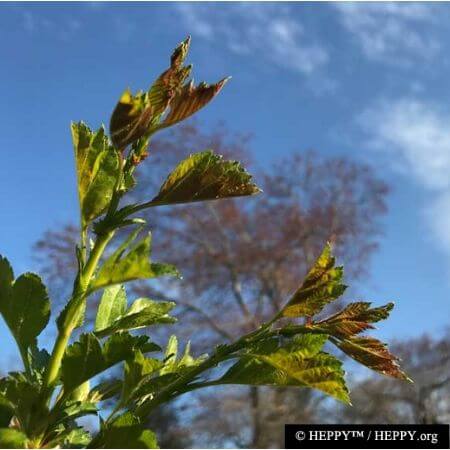
Chinese Hawthorn ‘Red Sun Chinese Haw’ growing at HEPPY
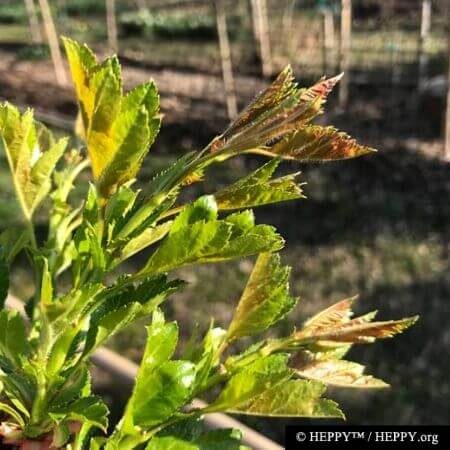
fin 2018, HEPPY purchased our ‘Red Sun Chinese Haw’ Chinese Hawthorn from England’s Orchard & Nursery . it’s a ~3 year old tree. it grows very vigorously and this year (2019) we’ll see if she fruits.
Named “Sanza,” for the Chinese Hawthorn true name, Shān zhā, she emerged from dormancy and is growing about 7+ inches per month! go girl!
volunteer at, or donate to HEPPY to see Sansa and other valuable plants thrive!
References
The Oregonian: Chinese haw
Plants for a Future: Crataegus pinnatifida
NIH / NCBI (PubMed): Crataegus pinnatifida: chemical constituents, pharmacology, and potential applications
NIH / NCBI (PubMed): Natural phenolic compounds from medicinal herbs and dietary plants: potential use for cancer prevention
NIH / NCBI (PubMed): Antioxidant activity and components of a traditional chinese medicine formula consisting of Crataegus pinnatifida and Salvia miltiorrhiza

